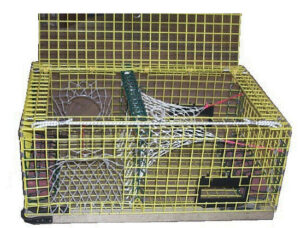Trap Design

Photo of Lobster Trap from National Oceanographic and Atmospheric Administration
Most modern-day lobster traps (also called pots) are rectangular(for easy stacking when out of water), and are constructed of coated wire mesh. Wire traps began to replace traditional wooden traps in the late 1970s. Wire traps require less maintenance and are lighter out of water (about 40 lbs. vs. 125 lbs.) than wet wooden traps – yet heavier in the water (about 35 lbs. vs. 7 lbs.) This makes them easier to maneuver out of water and more stable in the water. The typical trap costs between $150-$200.
Here’s how a lobster trap works:
A lobster will enter through the net “head” to go after the bait in a bait bag placed in the “kitchen.” When it tries to exit it lands in the “bedroom” or “parlor.” Some traps have more than one kitchen and bedroom. Traps are required to have an escape vent that is large enough to let all but the legal-sized lobsters escape. Traps are also equipped with runners that help prevent legs, claws and antennae from being pinched between the bottom of the trap and the boat when the traps are hauled. Most areas also require traps to have a biodegradable “ghost panel.” This panel will eventually degrade and release, allowing a large space for lobsters to escape from “ghost traps” (those that have broken free of their buoy lines and are therefore unretrievable).
